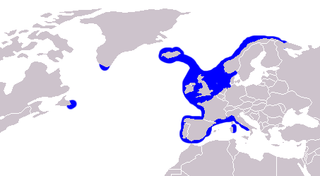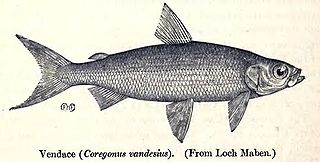
Chives, scientific name Allium schoenoprasum, is a species of flowering plant in the family Amaryllidaceae that produces edible leaves and flowers. Their close relatives include the common onions, garlic, shallot, leek, scallion, and Chinese onion.

Cod is the common name for the demersal fish genus Gadus, belonging to the family Gadidae. Cod is also used as part of the common name for a number of other fish species, and one species that belongs to genus Gadus is commonly not called cod.

The common ling, also known as the white ling or simply the ling, is a large member of the family Lotidae, a group of cod-like fishes. It resembles the related rocklings, but it is much larger and has a single barbel. This species is unrelated to the pink ling, Genypterus blacodes, from the Southern Hemisphere. The common ling is found in the northern Atlantic, mainly off Europe, and into the Mediterranean Basin. It is an important quarry species for fisheries, especially in the northeastern Atlantic, although some doubts exist as the sustainability of the fisheries. As an edible species, it is eaten fresh, frozen, or dried, but also preserved in lye, while the roe is a delicacy in Spain.

Coregonus vandesius, the vendace, is a freshwater whitefish found in the United Kingdom. Population surveys since the 1960s have revealed a steady decline and the fish is no longer present in some of its previous haunts but is still present in Bassenthwaite Lake and Derwent Water. The main threats it faces are eutrophication and the introduction of alien species of fish which eat its eggs and fry. The International Union for Conservation of Nature has rated its conservation status as "endangered".
Present-day Irish has numerous loanwords from English. The native term for these is béarlachas, from Béarla, the Irish word for the English language. It is a result of bilingualism within a society where there is a dominant, superstrate language and a minority substrate language with few or no monolingual speakers and a perceived "lesser" status.

A cuckold is the husband of an adulterous wife; the wife of an adulterous husband is a cuckquean. In biology, a cuckold is a male who unwittingly invests parental effort in juveniles who are not genetically his offspring.

Jin Ling is a Russian brand of cigarettes, currently owned and manufactured by the Kaliningrad-based manufacturer Baltic Tobacco Company. Other places where this brand is manufactured include Ukraine, Moldova, Cyprus and the United Arab Emirates.
LingCloud is a suite of open-source cloud computing system software developed by Institute of Computing Technology, Chinese Academy of Sciences. It is licensed under Apache License 2.0. LingCloud provides a resource single leasing point system for consolidated leasing physical and virtual machines, and supports various heterogeneous application modes including high performance computing, large scale data processing, massive data storage, etc. on shared infrastructure. LingCloud can help an organization to build private cloud to manage the computing infrastructure.
Events from the year 1606 in France
Salvelinus colii, also called Cole's char, Enniskillen char or Trevelyan's char, is a cold-water species of char fish in the family Salmonidae.

The Coomsaharn char is a species of lacustrine char fish in the family Salmonidae.

Salvelinus grayi, also called Gray's char[r], Lough Melvin char[r] or freshwater herring, is a species of lacustrine char fish in the family Salmonidae.

Salvelinus obtusus, commonly called the blunt-nosed Irish charr or blunt-snouted Irish char, is a species of lacustrine char fish in the family Salmonidae, found in the Lakes of Killarney, Ireland.
Spinitectoides is a genus of parasitic nematodes, belonging to the family Cystidicolidae. Species of Spinitectoides are parasitic as adults in the gastrointestinal tract of fish. According to the World Register of Marine Species, the genus currently (2019) includes a single species, Spinitectoides berlandi.

Helvick or Helvick Head is a headland on the southern end of Dungarvan Harbour, Ireland; it is the eastern tip of the Ring Peninsula.

The Spanish ling, also called the Mediterranean ling, is a species of fish in the family Lotidae.

The hollowsnout grenadier, also called the blackspot grenadier, is a species of fish in the family Macrouridae.

The rendezvous fish is a species of fish in the family Phosichthyidae (lightfish).
Leptostomias gladiator is a species of fish in the family Stomiidae. It is sometimes called the scaleless dragonfish, but that name is shared with many other species.
The longfin smooth-head is a species of fish in the family Alepocephalidae.












